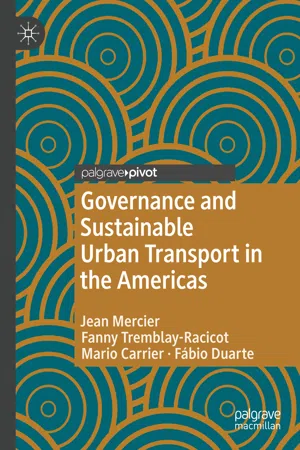1.1 Reducing Greenhouse Gases in Urban Areas
This book is about cities and, more specifically, about sustainable transport in cities and metropolitan areas of the Americas.
More than 50% of the world population now lives in cities “and city governments face a wide range of challenges: they need to produce wealth and innovation but also health and sustainability” (Meijer and Rodriguez Bolivar 2015, 2).
While cities cover no more than 2% of the earth’s landmass, “it is estimated that they consume 75 percent of the planet’s resources and produce 75 percent of all greenhouse gas emissions and are responsible for massive amounts of waste, pollution, and environmental degradation, of which the consequences are felt far beyond their territorial boundaries” (Bouteligier 2013, 8).
But if cities can be part of the problem, they can also be part of the solution, and “the confrontation with unsustainable situations leads to a quest for solutions [… and] cities will be important for realizing a shift to more sustainable global urban lifestyles” (Bouteligier 2013, 164), in good part because “they have particular advantages, such as economies of scale and proximity for infrastructure and services and the potential to become more energy efficient at relatively low cost” (4). This may be why the twenty-first century has been described as the beginning of the urban millennium.
It would be an exaggeration to say that cities are alone in responding to the challenges before them. There are other levels of governments and other actors in civil society. But ever since the alarm was sounded about growing greenhouse gases (GHG), the senior governments, and most notably national governments, have been slow to act (Barber 2013, 6, 19), to the point that some observers have concluded that “we have no politics of climate change” (Bache et al. 2015, 70). Considering this, “the city now looms large on the international climate change agenda” (Bulkeley and Betsill 2013, 136).
One of the policy domains where cities and metropolitan areas are facing the most pressing challenges is the policy for urban transport .
Among the three large sectors of the economy producing GHG , energy, industrial production and transport, it is the transport sector where the progress in reducing GHG is generally considered the least successful. In fact, GHG caused by transport continues, especially in the Americas (US Climate Action Report 2010; International Energy Agency 2013) to increase unabated, from year to year, two decades after the adoption of the Kyoto protocol. Considering, as stated earlier, that about half of humans are presently living in cities , and increasingly in quite large cities, it seems pertinent to look at how some cities from the Americas are doing better than others in urban transport and in containing the increase in private automobile use and in increasing public transit and non-motorized transportation (NMT), policies that are reputed to decrease greenhouse gas production from urban transportation . We can refer to cities that try to reach these goals as cities which have sustainable urban transportation systems, and one method of determining their level of success is by looking at what is called the “modal split”, i.e. the proportion of mobility assured by each mode, the private automobile, public transit, walking, and biking, essentially.
Drawing on figures from the modal split statistics of cities of the Americas, we have identified three cities with a respectable proportion of their mobility assured through public transit and NMT. These cities are the US city of Seattle , the Canadian city of Montreal , and, finally, the Brazilian city of Curitiba . Data on these statistics are presented in Table 1.1.
Table 1.1
Modal split in Seattle, Curitiba, and Montreal (2016)
Mode/city | Total transit and active modes (%) | Drive alone and motor bikes (%) | Carpooling (%) | Transit (%) | Bike (%) | Walk (%) | Work at home (%) | Other (%) | |
|---|---|---|---|---|---|---|---|---|---|
Seattlea | Metro area | 16.1 | 67.1 | 9.7 | 10.4 | 1.3 | 4.4 | 6.0 | 1.2 |
City | 35.7 | 48.1 | 7.1 | 21.0 | 3.5 | 11.2 | 7.6 | 1.6 | |
Montrealb | Metro area | 30.9 | 65.1 | 3.2 | 23.5 | 2.1 | 5.3 | N.A. | 1.0 |
City (island/agglo.) | 47.0 | 53.0 | 35.0 | 4.0 | 8.0 | N.A. | 1.0 | ||
Curitibac | Metro area | N.A. | N.A. | N.A. | N.A. | N.A. | N.A. | N.A. | N.A. |
City | 70.0 | 27.0 | N.A. | 45.0 | 5.0 | 20.0 | N.A. | 3.0 | |
In order to assess how these cities have achieved a more sustainable transportation system, we have focused in this book on which policies they have pursued and, more specifically, which policy instruments they have used to implement them. Since it appears that successful cities use a wide variety of instruments, presumably at different stages, to achieve the quite complex goal of sustainable urban transportation , we were interested in what were these instruments and how were they combined to achieve their success. Although different expressions are utilized, such as “policy tools” or “regulation”, in its widest sense, policy instruments refer to the means available to governments to influence or coerce business and citizens in a direction which it finds desirable (for closely resembling definitions, see Howlett 1991, 2...
